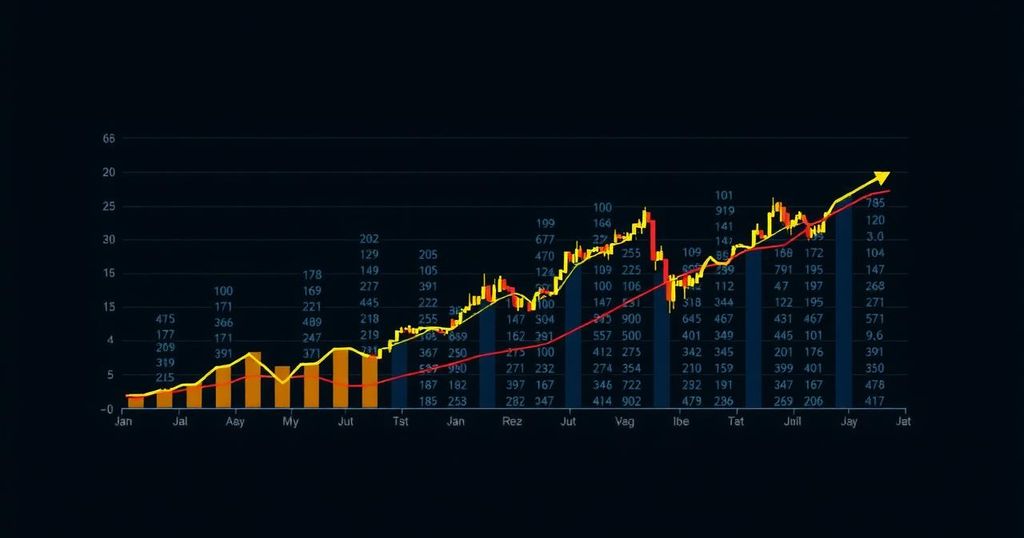Implications of the Federal Reserve’s Rate Cut on Bitcoin
Summary
The Federal Reserve’s substantial rate cut of 50 basis points indicates serious concerns regarding the U.S. economy’s health. While historically benefitting hard assets like Bitcoin, this aggressive cut presents both opportunities and risks amid growing economic instability and potential recession fears. The long-term outlook for Bitcoin remains strong as it serves as a hedge against central bank mismanagement, despite anticipated short-term volatility.
The Federal Reserve has enacted a significant interest rate reduction of 50 basis points, revising the federal funds rate to a range between 4.75% and 5%. This hefty cut, double the expected 25 basis points adjustment, reflects the Fed’s serious concerns regarding the state of the U.S. economy, especially in light of previously aggressive efforts to combat inflation. Within this context, Bitcoin, often recognized as a hedge against central banking mismanagement, faces implications both advantageous and risky in the near term. This unexpected rate decrease can be interpreted as a strong signal of economic distress. It suggests that the U.S. economy is not performing as well as government officials have indicated, with the Fed appearing to shift into damage control mode. Indicators such as stagnating job growth coupled with structural weaknesses in the financial system hint at deeper recessionary fears. For Bitcoin, the immediate implications of the 50 basis points cut are mixed. Traditionally, such cuts have been beneficial for hard assets, including Bitcoin, as they often lead to inflationary pressures that direct capital towards stores of value. However, this cut does not signify a typical easing of monetary policy; it is rather an emergency measure necessitated by economic instability. Consequently, if market participants view this reduction as an indication of more profound economic troubles, Bitcoin’s value may endure a risk-off selloff. Recently, Bitcoin has exhibited volatility, having difficulty retaining gains from the summer peak of $65,000 to under $59,000. This prevailing uncertainty about the economy’s direction is likely to fuel further short-term turbulence following the Fed’s latest intervention. The macroeconomic environment further complicates matters. Reports reveal a declining labor market, with new job creation falling short of expectations and unemployment rising to 7.1 million. Such economic weakness, combined with sluggish consumer spending and decreasing industrial output, reinforces the notion of an impending recession. Internationally, economic challenges persist in Europe, Japan, and China, introducing a global context to the Fed’s strategic pivot. Despite these immediate challenges, the long-term outlook for Bitcoin remains promising. As central banks continue to grapple with economic weaknesses globally, their response has been to increase the money supply through various measures. In this framework, Bitcoin’s role as a decentralized financial network may grow in significance, as it stands apart from any individual nation’s monetary policies. In conclusion, while the Federal Reserve’s aggressive decision to cut interest rates may usher in a turbulent phase for Bitcoin driven by market re-evaluations of the economy’s health, the fundamental case for Bitcoin as a viable alternative to traditional fiat currencies remains robust. Investors may face increased volatility in the short term; however, those who recognize Bitcoin’s intrinsic value may perceive this rate cut as yet another affirmation of its potential.
The Federal Reserve’s decision to reduce interest rates is a critical monetary policy action that reflects underlying economic conditions. After a year characterized by efforts to control inflation through rate increases, the Fed’s latest move suggests an acknowledgment of deeper economic troubles. The intersection of interest rates, inflation, and asset prices, particularly for Bitcoin, resonates deeply within the broader framework of both U.S. and global economies facing potential recessionary pressures and instability. This context is essential for understanding how monetary policy shifts affect asset valuations and investor sentiment.
The Federal Reserve’s bold move to cut interest rates by 50 basis points highlights significant economic challenges faced by the U.S. economy. For Bitcoin, this may lead to short-term volatility as markets recalibrate. However, the long-term prospects for Bitcoin as a store of value remain compelling, bolstered by ongoing monetary expansion and the need for assets that operate outside the constraints of traditional financial systems. Investors with confidence in Bitcoin’s decentralized nature may ultimately view this policy change as an endorsement of its value.
Original Source: www.forbes.com








Post Comment